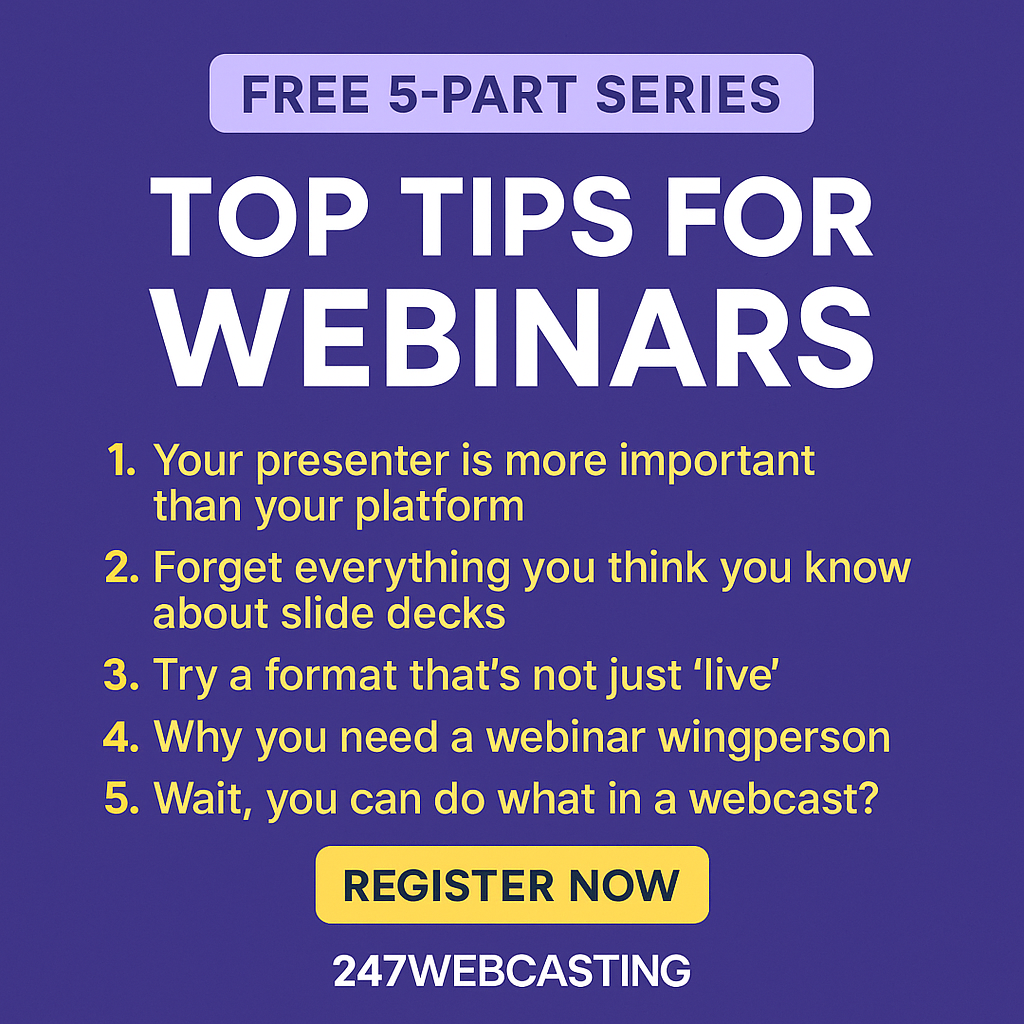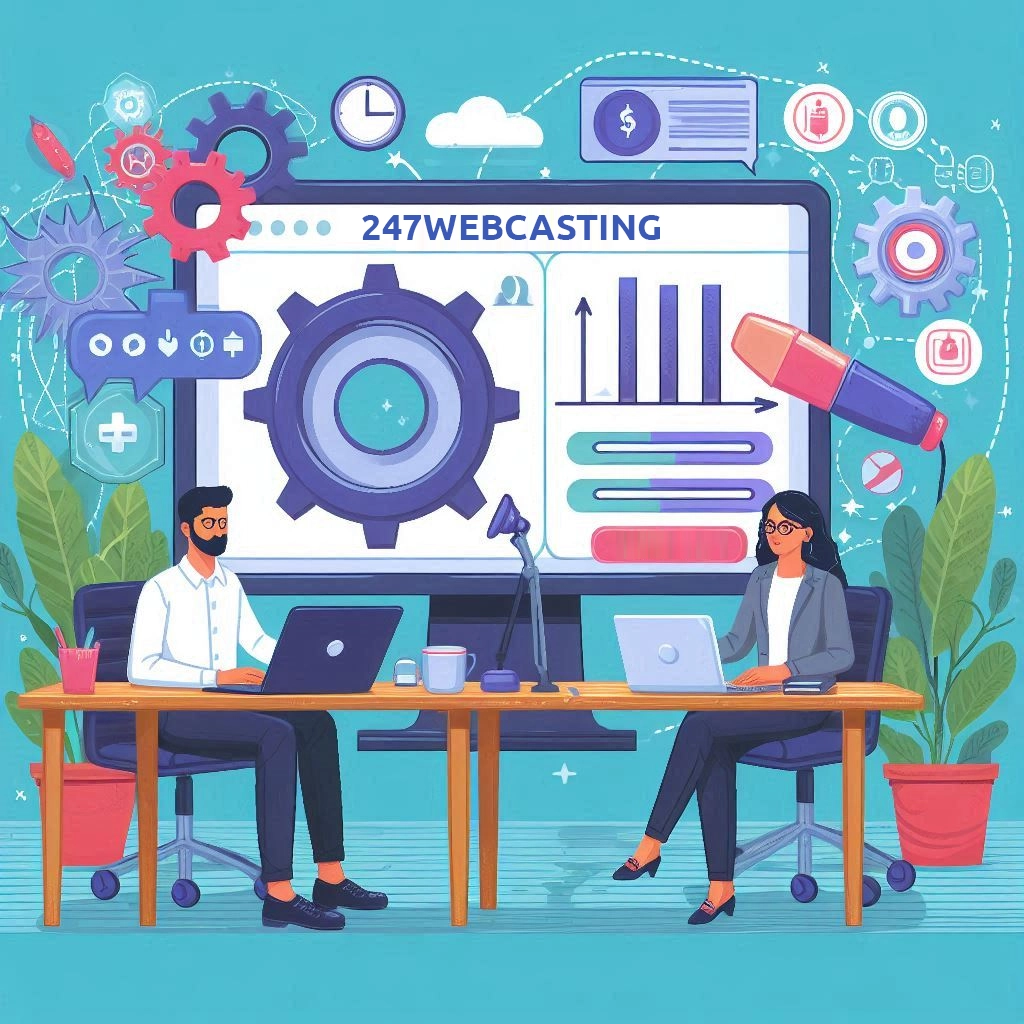Part 1: REGISTRATION
The key to great webinar design is giving equal importance to both how your webinar looks, and how engaging it is for your audience; this is the classic design principle of form following function.
It may sound simple, but after well over a decade in the industry, we at 247 Webcasting have seen some absolute horror shows of webinar ‘design’! Webinars that look more like a teenager’s first attempt at a Myspace page, than a professional, engaging, aesthetically pleasing virtual experience.
The very best webinars combine a clean, intuitive layout; data-capture fields and engagement tools to both inform your audience, drive engagement, and increase sign-up and interaction; clear, focussed and visually appealing branding with a complementary colour palette; and have visual and branding consistency throughout the entire User Experience (UX) – from Registration, all the way through to Attendance and post-event communications.
Our expert team of Webcast Managers are all graphically-trained and are always on-hand to not just build your Webinar, but to guide you through the design process and ensure your Registration pages, Lobby page, Emails, and Webinar Console strike the perfect balance between form and function, all while best representing your brand (adhering to even the most stringent of branding guidelines) and creating a truly engaging experience for your attendees.
So, what makes a Good Webinar? What could be considered Bad design? And how do you avoid the downright Ugly? Let’s take a look at the first stage of the process; Registration.
Part 1: Registration Pages
It all starts here; this is where your audience’s Webinar journey begins!
The Registration Page is normally the first branded and themed page your future audience will see, and obviously has a major impact on whether a visitor will relinquish their valuable sign-up data, and ultimately invest their time in your content!
But don’t make the mistake of thinking of it as merely a page to capture data; think of it as your shop window. It needs to be attractive, enticing, representative of your brand, and provide a visitor with a genuine reason to enter your shop (or in this case, provide their registration details).
You want to give them enough information so they can see the benefit of attendance, but not so much that they feel like they’ve seen your content before the webinar has even broadcast!
So, what should your Registration Page look like? Well, as 247 Webcasting bespoke-build every part of your webinar, the options are only really limited by your imagination, but let’s look at some basic Dos and Don’ts, starting with what NOT to do …
The BAD

- The banner isn’t the correct size for the page, the logos are not consistent in size and are misaligned, the image is in too low a resolution, and the text is unreadable.
Main Page (Body Copy and Data Capture):
- The entire page is too long. If visitors have to scroll to the bottom of a lengthy sign-up page, before they even reach the data-capture fields, this will negatively impact your conversion/sign-up rate.
- Far too many registration fields. This can be a real turn-off to your audience, as they are still at the pre-commitment stage, and this page demands they give up too much data. Gather only those details that you need at this stage (you can always gather more through the use of engagement tools during the webinar itself!)
- Content is just a solid block of text, with no eye breaks or called-out key points. This makes your copy hard to digest and can lead visitors to simply ignore your content and leave the page. Remember, this is your shop window and you want to provide clear, concise, and enticing reasons for them to enter your Webinar. What’s more, by making your content and proposition clear, you will ensure that your target audience will be the ones most likely to register.
- The page just uses a flat colour palette. It doesn’t matter how salient your content if it’s boring to the eye! You want to provide a page that’s visually appealing, in order to entice the viewer to scan the page and digest the content. This can be done simply through the use of a varied palette, or by applying a background image or colour (don’t forget that our guys are here to do all the technical bits for you!)
So, if that’s one example of Bad (and a little bit Ugly) Registration Page design, let’s have a look at how it should look …
The GOOD

- The banner image perfectly frames the columns; the graphics are the correct resolution so looks of a far higher quality; and everything is correctly sized and positioned.
Main Page (Body Copy and Data Capture):
- We have divided the page into two columns; this allows all the content to be seen on one screen without any additional scrolling. By adopting a side-by-side layout, you are making it easier for the visitor to digest the main content, while giving prominence to the hero section of the page – to get them to sign-up!
Column 1 (Body Copy):
- There is no right or wrong approach to which side your content should go, and which side your registration fields/data capture should go. Just as long as they are separated.
However, most people adopt a left-to-right gaze pattern when viewing online content, so it makes sense for the content to go in column 1, and once they have read and digested what the webinar is about, they would then move to column 2 to provide their details.
Believe it or not, the content on this Registration Page still contains all the same important information as the Bad example page, but through the use of page spacing, paragraphs, columns, and bullet points, it is far cleaner, more appealing, and easier to digest.
However, as previously mentioned, you want to adopt a ‘less is more’ approach to your Registration Page; don’t give away too much content, as you want to entice the visitor to sign up to your event!
Column 2 (Data Capture):
- Provide a brief yet clear event overview, and if you are targeting a multi-national audience, then it’s great practice to include multiple time zones. This will make your event more inclusive for audience members based in other countries, and let them know that it is not just geared towards the UK market.
- Use clear and concise registration fields, and only request the data that you absolutely need at this stage, rather than trying to collate all the data you want. The more compulsory data fields you include, the lower your sign-up conversion rate will be. However, if there’s information that will help you achieve your webinar goals, or better tailor your webinar content (your ‘nice to have’ data list), then you can simply make it an optional data field – that way your potential audience member can make their own decision, rather than feeling pressured into providing more details than they feel comfortable with.
But be careful with listing too many of these optional fields; don’t get data-greedy! Remember that you can always include Q&As, live polling, or post-event surveys into your Webinar content to capture additional data (again, our team is here to build the technical elements for you!)
- Including an Opt In/Opt Out. Make sure everything you do is both legally compliant and courteous to your attendees. Online etiquette is a key factor in whether you are seen as a deliverer of worthwhile content or a potential provider of spam!
- Don’t forget the little design touches! Adding small design features, such as colour-coded buttons, can really enhance the overall appearance of the entire page, and provide a far more appealing and professional visual finish.
So, there you have it, the 247 Webcasting guide to Registration Page Design. But the Registration Page is just the first stage of the Webinar experience, so keep your eyes peeled for our next post in The Good, the Bad, and the Ugly (of Webinar Design!) series.
Or if you can’t wait that long, then why not drop us an email or give us a call, and we can offer our expert advice on what we can do for your next online event!



